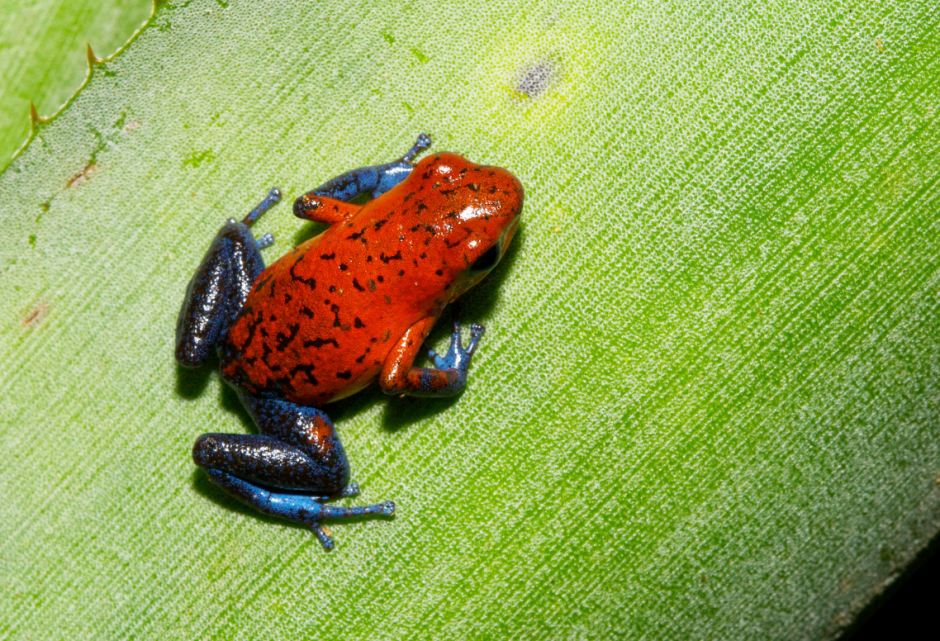
Getting this Shot – Poison Arrow Frog in Costa Rica
If you are headed to Costa Rica, you’ll certainly be on the look out for these amazing little critters, especially in the lowland Atlantic rainforests (e.g., Tortuguero, Sarapiqui, Tiskitia, etc.). What they lack in size, they no doubt make up in beauty. However, they are indeed small in size, about the size of a dime! Thus, you’ll want to read below for a step by step on how to photograph one of these guys, and perhaps even check out my macro photography section for general info.
Well, it’s no surprise that something the size of a dime and lives in the underbrush of tropical jungles is difficult to spot. Thus, it’s rather important to have very keen eyes and/or an excellent naturalist guide to help locate them.
And before even going out to find these little frogs, it’s important that you have the right camera setup and settings dialed in so that when you do find one, you are ready to go at a moment’s notice.
1. You’ll indeed want to get into “macro mode”, both physically and mentally, as well as photographically. What this means is that you have to be ready to get on the ground, a little dirty, and have some patience. In addition, you’ll need to have your camera dialed into macro settings. If you have a camera with automatic macro settings (i.e., most point and shoots), you’ll be looking for a small flower icon. Push this once or twice to enable macro mode, which has your camera prioritize for minimum focusing distance and maximum depth of field. If you do have a point and shoot with this automatic macro feature, skip to step #5.

2. If you have a DSLR, mirrorless, or other camera that has interchangeable lenses, you’ll want to get your lens with the smallest minimum focusing distance on your camera. Generally this is denoted by a small flower icon on the barrel of the lens and a distance measured in either meters or inches. The smaller the number the better. Most wide angle lenses have a minimum focusing distance of 0.3m or 9 inches, or something like that. This is great. (if you have a dedicated macro lens, this is a bonus!)
3. Then, you’ll want to set your focus to manual and dial your focusing ring to the closest distance possible (the opposite direction of infinity). And next, if this lens has zoom capabilities, you’ll want to zoom all the way in. For an 18-55mm or 24-105mm, this means all the way to 55mm or 105mm. What this does is make the subject the largest possible in your sensor…the essence of macro.
4. Lastly, you’ll want to use your flash, whether built in or external, put your camera on manual mode, and dial in an aperture of f/16 and a shutter speed of 1/200. As far as ISO goes, the easiest thing is to set ISO on AUTO, but if your camera does not allow this, aim for ISO 800 and experiment to see if this needs to go up at all from there (e.g. ISO 1600) to accommodate the high aperture and relatively fast shutter speed.
5. Whew…that was a lot! Now, it’s time to get the shot. So, you’ve found your frog, your camera is ready, it’s time to take the photo! When you’ve found your subject, you will move back and forth to get the subject in focus, since your camera is set on manual focus at minimum focusing distance. When the subject comes into focus – fire away – and be quick! This makes sure the subject is the largest it possibly can be in the sensor, based on the tips and settings above.
The beauty of macro photography is that it really emphasizes the subject in a way that you don’t need to overthink the background or even composition. However, if you want to take your photo to the next level, you’ll need to still think about both. For background, you’re pretty much at the mercy of where the frog is, as you don’t want to disturb them too much. But, as you can see from below compared to the top photo, what sort of background the frog is on does indeed make a difference in the impression of the resulting photo.

And composition, frankly, is something that you’ll always want to take into account. The easiest way is to adhere to the rule of thirds, and generally have the animal facing in the direction of the open space of the photo (i.e., the two thirds left open).
8. And voila! You have the above shot. But, as you can tell, there are so many more strategies and opportunities for these kinds of photos. Now, its your turn to get out there and get some extraordinary photos!
Enjoy!
Court
Leave a reply